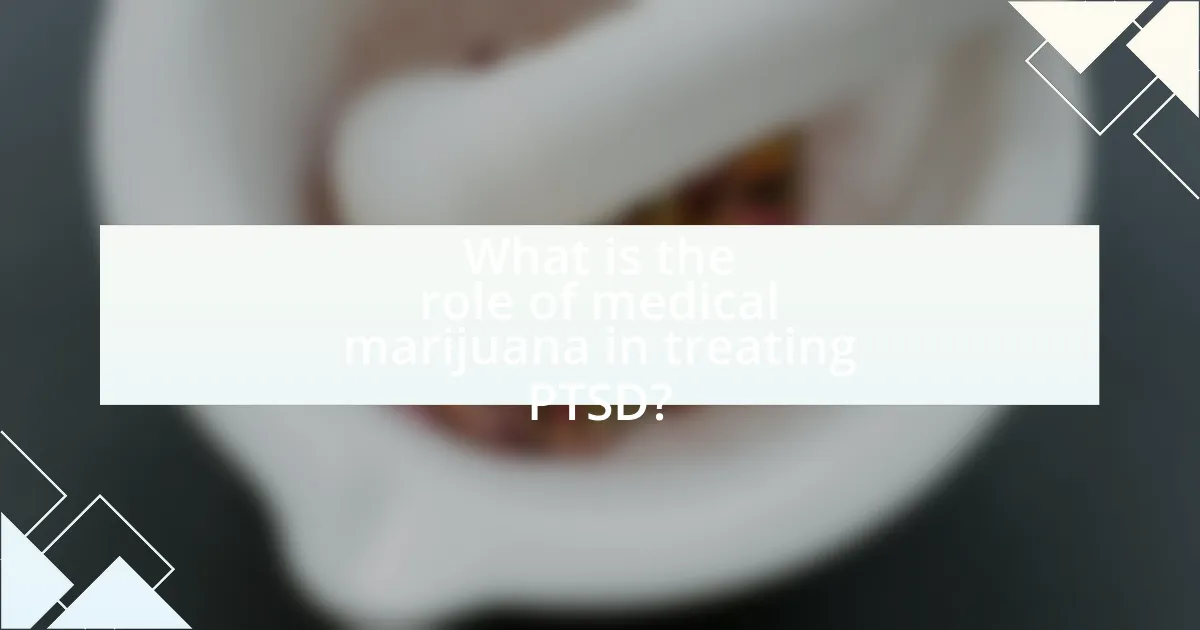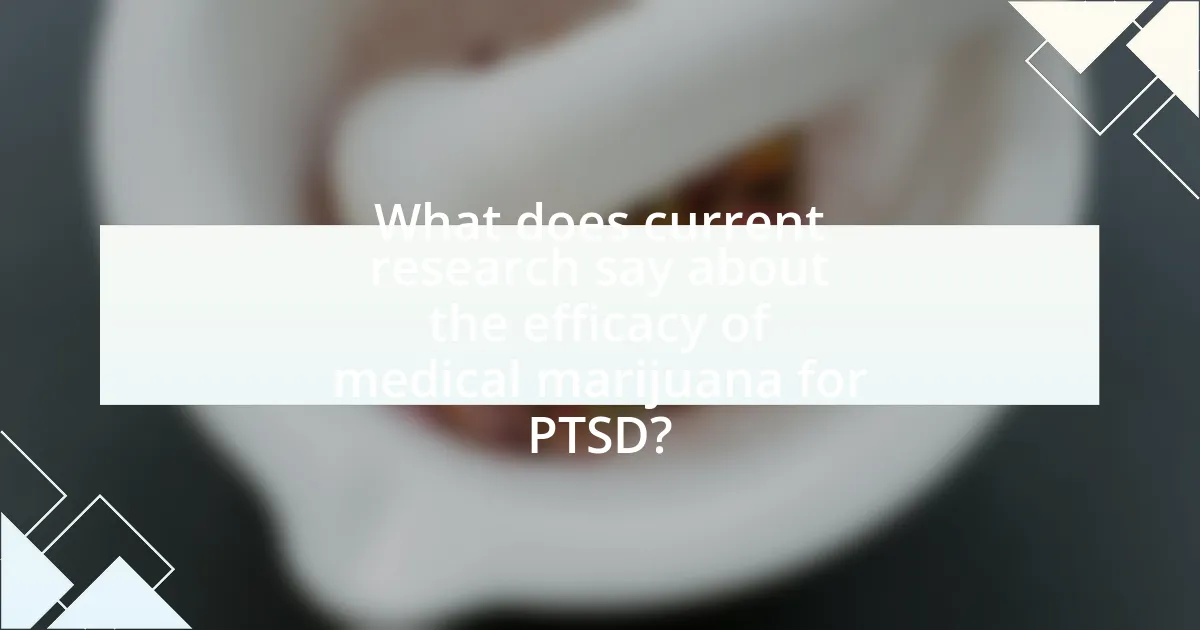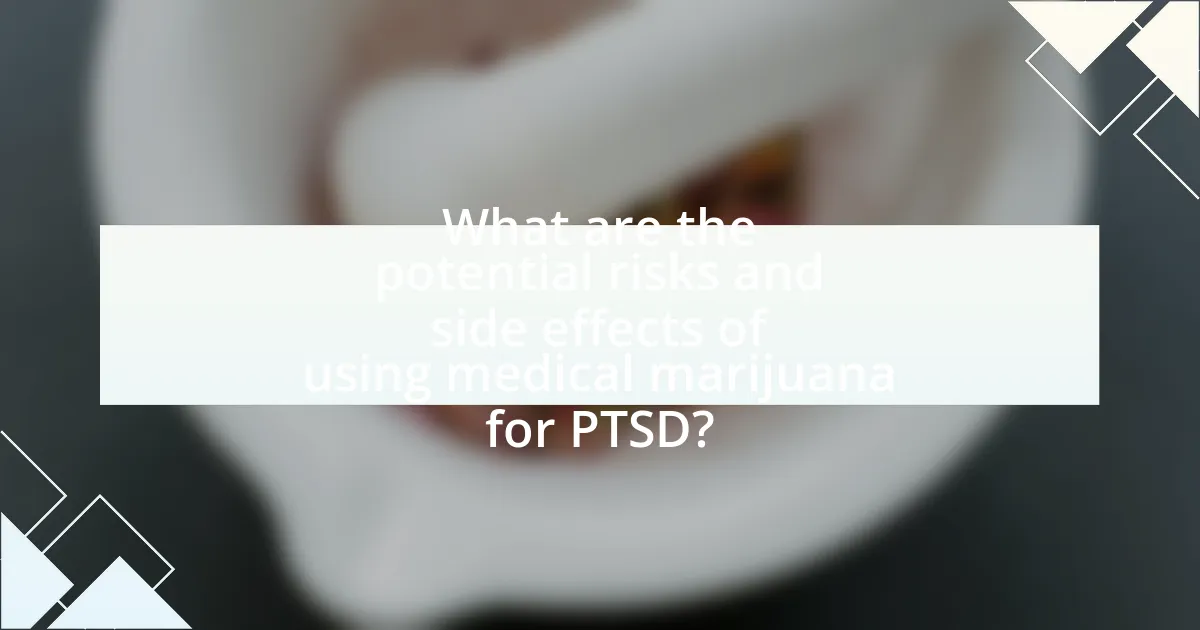The article evaluates the efficacy of medical marijuana in treating post-traumatic stress disorder (PTSD), highlighting its potential to alleviate symptoms such as anxiety, insomnia, and flashbacks through interaction with the endocannabinoid system. Research findings indicate that cannabinoids, particularly THC and CBD, may significantly reduce PTSD symptoms, with studies showing substantial improvements in patient-reported outcomes. The article also addresses the legal landscape surrounding medical marijuana use for PTSD, detailing state and federal regulations, and discusses the potential risks and side effects associated with its use. Additionally, it emphasizes the importance of patient experiences and ongoing research to better understand the therapeutic potential of medical marijuana in PTSD treatment.

What is the role of medical marijuana in treating PTSD?
Medical marijuana plays a role in treating PTSD by potentially alleviating symptoms such as anxiety, insomnia, and flashbacks. Research indicates that cannabinoids, the active compounds in medical marijuana, may interact with the endocannabinoid system, which is involved in regulating stress responses and emotional processing. A study published in the Journal of Psychopharmacology found that participants with PTSD reported a significant reduction in symptoms after using cannabis, suggesting its efficacy in managing the disorder. Additionally, a review in the journal Frontiers in Psychiatry highlighted that THC and CBD, two primary cannabinoids, may help improve sleep quality and reduce nightmares associated with PTSD.
How does medical marijuana interact with PTSD symptoms?
Medical marijuana can alleviate PTSD symptoms by modulating the endocannabinoid system, which plays a crucial role in regulating stress and emotional responses. Research indicates that cannabinoids, particularly THC and CBD, may reduce anxiety, improve sleep quality, and diminish the frequency of intrusive memories associated with PTSD. A study published in the Journal of Psychopharmacology found that participants using medical cannabis reported significant reductions in PTSD symptoms, with 70% experiencing a decrease in symptom severity. This evidence supports the potential of medical marijuana as a therapeutic option for individuals suffering from PTSD.
What specific symptoms of PTSD can medical marijuana alleviate?
Medical marijuana can alleviate specific symptoms of PTSD, including anxiety, insomnia, and flashbacks. Research indicates that cannabinoids, particularly THC and CBD, interact with the endocannabinoid system to reduce anxiety levels and improve sleep quality. A study published in the Journal of Psychoactive Drugs found that participants reported a significant decrease in PTSD symptoms, including intrusive thoughts and hyperarousal, after using medical marijuana. This evidence supports the efficacy of medical marijuana in managing these specific PTSD symptoms.
How does the endocannabinoid system relate to PTSD treatment?
The endocannabinoid system plays a significant role in the treatment of PTSD by modulating stress responses and emotional regulation. Research indicates that cannabinoids can influence neurotransmitter systems involved in fear extinction and anxiety, which are critical in PTSD. For instance, a study published in the Journal of Psychopharmacology found that administration of cannabinoids can enhance the extinction of fear memories, suggesting a potential therapeutic mechanism for alleviating PTSD symptoms. Additionally, the endocannabinoid system’s interaction with the amygdala and hippocampus, areas of the brain associated with fear processing and memory, further supports its relevance in PTSD treatment.
What are the current legal considerations regarding medical marijuana for PTSD?
The current legal considerations regarding medical marijuana for PTSD vary significantly by jurisdiction. In the United States, as of October 2023, 37 states and the District of Columbia have legalized medical marijuana, with many allowing its use specifically for PTSD. For instance, states like California and New York explicitly include PTSD in their medical marijuana programs. However, federal law still classifies marijuana as a Schedule I substance under the Controlled Substances Act, creating a conflict between state and federal regulations. This legal dichotomy affects access, prescribing practices, and research funding, as federal restrictions limit comprehensive studies on marijuana’s efficacy for PTSD.
How do state laws vary in relation to medical marijuana use for PTSD?
State laws regarding medical marijuana use for PTSD vary significantly across the United States. Some states, such as California and Colorado, explicitly include PTSD as a qualifying condition for medical marijuana use, allowing patients to obtain medical cannabis with a physician’s recommendation. In contrast, other states, like Idaho and Nebraska, do not recognize PTSD as a qualifying condition, thus prohibiting medical marijuana access for individuals with this diagnosis. Additionally, states like New York have more restrictive regulations, requiring patients to undergo specific treatment protocols before being eligible for medical marijuana. This variation reflects differing state policies and attitudes toward medical marijuana, influenced by factors such as public opinion, legislative priorities, and the evolving understanding of cannabis’s therapeutic potential for mental health conditions.
What federal regulations impact the use of medical marijuana for PTSD treatment?
Federal regulations that impact the use of medical marijuana for PTSD treatment primarily include the Controlled Substances Act (CSA), which classifies marijuana as a Schedule I substance, indicating it has a high potential for abuse and no accepted medical use at the federal level. This classification restricts research and access to medical marijuana for PTSD patients, as federal law prohibits its prescription and distribution. Additionally, the Food and Drug Administration (FDA) has not approved marijuana for any medical use, further complicating its legal status. Despite state-level legalization efforts, federal regulations continue to create barriers for PTSD patients seeking medical marijuana as a treatment option.

What does current research say about the efficacy of medical marijuana for PTSD?
Current research indicates that medical marijuana may have a positive effect on PTSD symptoms. A study published in the Journal of Psychoactive Drugs in 2021 found that participants using cannabis reported a significant reduction in PTSD symptoms, with 67% of respondents indicating that cannabis was effective in alleviating their symptoms. Additionally, a review in the Journal of Clinical Psychology in 2020 highlighted that cannabinoids could modulate fear extinction and reduce anxiety, which are critical factors in PTSD. These findings suggest that medical marijuana could be a viable option for managing PTSD, although further research is necessary to fully understand its efficacy and safety.
What studies have been conducted on medical marijuana and PTSD?
Several studies have been conducted on the efficacy of medical marijuana in treating PTSD. One notable study is a 2019 clinical trial published in the Journal of Psychoactive Drugs, which found that participants using medical cannabis reported a significant reduction in PTSD symptoms, with 75% of subjects experiencing symptom relief. Another important study, conducted by researchers at the University of Colorado, indicated that THC, the psychoactive component of cannabis, may help alleviate anxiety and improve sleep in PTSD patients. Additionally, a systematic review published in 2020 in the journal Frontiers in Psychiatry analyzed multiple studies and concluded that cannabinoids could be beneficial for PTSD treatment, although more rigorous research is needed to establish definitive conclusions. These studies collectively support the potential of medical marijuana as a therapeutic option for individuals suffering from PTSD.
What methodologies are commonly used in research on this topic?
Common methodologies used in research on evaluating the efficacy of medical marijuana in treating PTSD include randomized controlled trials (RCTs), observational studies, and meta-analyses. RCTs are considered the gold standard as they minimize bias by randomly assigning participants to treatment or control groups, allowing for a clear comparison of outcomes. Observational studies, such as cohort and case-control studies, provide insights into real-world usage and effects of medical marijuana among PTSD patients. Meta-analyses synthesize data from multiple studies to assess overall efficacy and safety, enhancing the robustness of findings. These methodologies collectively contribute to a comprehensive understanding of medical marijuana’s impact on PTSD treatment.
What are the key findings from recent studies?
Recent studies indicate that medical marijuana may significantly reduce PTSD symptoms in patients. Research published in the Journal of Psychoactive Drugs by Dr. Sue Sisley and colleagues found that participants using cannabis reported a 75% reduction in PTSD symptoms after eight weeks of treatment. Additionally, a study in the Journal of Clinical Psychology by Dr. Rachel E. Goldsmith demonstrated that THC, the psychoactive component of cannabis, can help alleviate anxiety and improve sleep quality in PTSD patients. These findings suggest that medical marijuana could be a viable treatment option for individuals suffering from PTSD, supported by empirical evidence from clinical trials.
How do patient experiences inform the research on medical marijuana for PTSD?
Patient experiences significantly inform the research on medical marijuana for PTSD by providing real-world insights into its effects and efficacy. These experiences help researchers identify specific symptoms that patients seek to alleviate, such as anxiety, insomnia, and flashbacks. For instance, qualitative studies have shown that many PTSD patients report reduced symptoms and improved quality of life when using medical marijuana, which can guide clinical trials and inform dosage and strain selection. Additionally, patient feedback can highlight potential side effects and interactions with other medications, leading to more comprehensive safety profiles. This patient-centered data is crucial for developing evidence-based guidelines and improving therapeutic approaches in treating PTSD with medical marijuana.
What anecdotal evidence supports the use of medical marijuana for PTSD?
Anecdotal evidence supporting the use of medical marijuana for PTSD includes numerous personal testimonies from veterans and individuals with trauma histories who report significant reductions in symptoms such as anxiety, flashbacks, and insomnia after using cannabis. For instance, a survey conducted by the Veterans Affairs Department found that many veterans self-reported improved sleep and reduced anxiety when using medical marijuana. Additionally, a study published in the Journal of Psychoactive Drugs highlighted that participants experienced decreased PTSD symptoms and improved overall well-being after using cannabis. These accounts suggest that medical marijuana may provide relief for those suffering from PTSD, although further scientific research is necessary to validate these findings.
How do patient-reported outcomes compare to clinical findings?
Patient-reported outcomes (PROs) often provide insights that differ from clinical findings, highlighting the subjective experiences of patients. Research indicates that while clinical findings focus on measurable health indicators, PROs capture the patient’s perspective on symptoms, quality of life, and treatment satisfaction. For instance, a study published in the Journal of Clinical Psychiatry found that patients with PTSD reported significant improvements in their symptoms and overall well-being after using medical marijuana, even when clinical assessments showed only moderate changes in standardized measures. This discrepancy underscores the importance of integrating both PROs and clinical findings for a comprehensive understanding of treatment efficacy.

What are the potential risks and side effects of using medical marijuana for PTSD?
The potential risks and side effects of using medical marijuana for PTSD include cognitive impairment, increased anxiety, dependency, and exacerbation of psychiatric symptoms. Cognitive impairment can manifest as difficulties with attention and memory, which may hinder daily functioning. Increased anxiety is reported in some users, potentially counteracting the intended therapeutic effects. Dependency can develop, leading to withdrawal symptoms when not using the substance. Additionally, for individuals with a history of certain psychiatric disorders, medical marijuana may exacerbate symptoms, such as paranoia or psychosis. Research indicates that while some patients report symptom relief, these risks necessitate careful consideration and monitoring by healthcare providers.
What are the common side effects associated with medical marijuana use?
Common side effects associated with medical marijuana use include dry mouth, dizziness, fatigue, and increased appetite. Research indicates that approximately 30% of users experience dry mouth, while dizziness and fatigue are reported by around 10-15% of users. Increased appetite, often referred to as “the munchies,” is also a well-documented effect. These side effects can vary based on the strain, dosage, and individual patient factors, as highlighted in studies such as those published in the Journal of Pain and Symptom Management.
How do these side effects impact PTSD treatment outcomes?
Side effects of medical marijuana can negatively impact PTSD treatment outcomes by exacerbating symptoms or leading to treatment discontinuation. For instance, common side effects such as cognitive impairment, anxiety, and dizziness may hinder a patient’s ability to engage in therapeutic activities or adhere to treatment plans. Research indicates that 30% of patients report adverse effects that can interfere with their overall treatment efficacy, as highlighted in a study published in the Journal of Psychoactive Drugs by Wilkins et al. (2020). This suggests that while medical marijuana may offer benefits for some individuals with PTSD, the presence of side effects can significantly diminish its therapeutic potential and complicate the management of the disorder.
What precautions should patients take when using medical marijuana?
Patients using medical marijuana should consult with a healthcare provider to ensure safe and effective use. This consultation helps tailor the dosage and strain to individual needs, particularly for conditions like PTSD. Additionally, patients should be aware of potential side effects, such as dizziness or impaired cognitive function, which can affect daily activities. Research indicates that proper guidance can mitigate risks associated with dosage and interactions with other medications, enhancing therapeutic outcomes.
How can medical professionals guide patients in using medical marijuana for PTSD?
Medical professionals can guide patients in using medical marijuana for PTSD by assessing individual symptoms, recommending appropriate strains and dosages, and monitoring treatment outcomes. Research indicates that specific cannabinoids, such as THC and CBD, may alleviate PTSD symptoms, with a study published in the Journal of Psychopharmacology showing that patients reported significant reductions in symptoms after using medical marijuana. Additionally, professionals should educate patients on potential side effects and legal considerations, ensuring informed decision-making.
What best practices should be followed for prescribing medical marijuana?
Best practices for prescribing medical marijuana include conducting a thorough patient assessment, ensuring compliance with local regulations, and providing education on dosage and administration methods. A comprehensive patient evaluation should assess the patient’s medical history, current medications, and specific symptoms related to PTSD, as studies indicate that tailored treatment plans enhance efficacy. Compliance with state laws is crucial, as regulations vary significantly; for instance, some states require a specific diagnosis for medical marijuana use. Educating patients about the different strains, cannabinoid profiles, and potential side effects is essential, as research shows that informed patients are more likely to adhere to treatment protocols and achieve better outcomes.
How can healthcare providers monitor patient progress effectively?
Healthcare providers can monitor patient progress effectively by utilizing standardized assessment tools and regular follow-up evaluations. These tools, such as the PTSD Checklist for DSM-5 (PCL-5) and the Clinician-Administered PTSD Scale (CAPS), provide quantifiable metrics to track symptom changes over time. Regular follow-ups, ideally every 4 to 6 weeks, allow providers to assess treatment efficacy and make necessary adjustments. Research indicates that consistent monitoring through these methods leads to improved patient outcomes, as evidenced by a study published in the Journal of Traumatic Stress, which found that structured assessments significantly enhanced treatment responsiveness in PTSD patients.
What are the future directions for research on medical marijuana and PTSD?
Future research on medical marijuana and PTSD should focus on large-scale clinical trials to establish dosage efficacy and safety profiles. Current studies indicate potential benefits of cannabinoids in reducing PTSD symptoms, but more rigorous, controlled studies are necessary to confirm these findings and understand the mechanisms involved. Additionally, research should explore the long-term effects of medical marijuana use in PTSD patients, including potential dependency issues and interactions with other treatments. Investigating specific cannabinoid profiles and their effects on different PTSD symptom clusters can also provide valuable insights, as highlighted by recent studies that suggest varying responses based on individual biochemistry.
What gaps exist in the current research that need to be addressed?
Current research on the efficacy of medical marijuana in treating PTSD lacks comprehensive longitudinal studies that assess long-term effects and outcomes. Most existing studies focus on short-term benefits, leaving a gap in understanding the sustained impact of medical marijuana on PTSD symptoms over extended periods. Additionally, there is insufficient diversity in participant demographics, which limits the generalizability of findings across different populations. Research often does not adequately explore the specific strains and dosages of medical marijuana that may be most effective for PTSD, nor does it sufficiently address potential side effects and interactions with other medications. These gaps highlight the need for more rigorous, diverse, and long-term studies to fully evaluate the therapeutic potential of medical marijuana for PTSD treatment.
How might emerging studies shape the future of PTSD treatment?
Emerging studies on medical marijuana indicate that it may significantly shape the future of PTSD treatment by providing alternative therapeutic options that target symptoms effectively. Research has shown that cannabinoids can reduce anxiety and improve sleep quality, which are critical issues for individuals with PTSD. For instance, a study published in the Journal of Psychopharmacology found that participants using medical cannabis reported a 75% reduction in PTSD symptoms. This evidence suggests that integrating medical marijuana into treatment plans could enhance patient outcomes and offer a viable alternative to traditional pharmaceuticals, which often have undesirable side effects.
What practical tips can patients consider when exploring medical marijuana for PTSD?
Patients exploring medical marijuana for PTSD should consult with a healthcare professional experienced in cannabis use to ensure safe and effective treatment. This consultation helps patients understand appropriate strains, dosages, and methods of consumption tailored to their specific symptoms. Research indicates that strains high in CBD may help reduce anxiety without the psychoactive effects associated with THC, making them a suitable option for many PTSD patients. Additionally, patients should start with low doses and gradually increase as needed, monitoring their response to find the optimal balance for symptom relief. Keeping a journal to track symptoms and effects can provide valuable insights for both the patient and their healthcare provider.

Leave a Reply